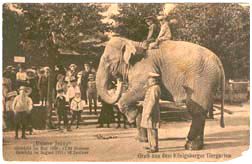Started by the Tiergarten in 1896, the zoo was home to 782 different specimens, including lions, tigers, cougars, leopards, deer, donkeys, badgers, monkeys, kangaroos, parrots and hummingbirds. For the price of 50 pfennigs (adults) or 20 pfennigs (children) Koenigsbergers could enjoy a complete cultural experience. The zoo featured an arboretum where exotic plants grew like the gingko tree.
Music lovers could attend any one of the daily concerts given at the Concerthaus. Moneys received went towards the care of the animals. Patrons looking for relaxation could visit the Kurhaus or spa hotel. Hungry patrons could savour one of the mouth watering pastries from the Konditerei.
The Koenigsberg Zoo reached its peak in the early 1900's. It closed temporarily during the First World War and saw a change of ownership in 1938. The Second World War was even less kind to the zoo and its animals. as author Henry Steele Commager explains:
"I was present when the last Germans were cleared from the Koenigsberg Zoo, one of the hottest battle zones on this front. The zoo was in a terrible state of chaos. The elephant, unfed for many days, trumpeted for food. The monkeys had escaped from their broken cages and ran after the Red Army men, who threw them bits of bread. The parrots and the hummingbirds died. They flew away from their heated cages, and perished in the frosty air. Blizzards swept Koenigsberg for nearly a fortnight."
Only four animals survived the war: a deer, donkey, badger and hippo. A skeleton of its former self, the zoo closed and re-opened as the Kalingrad Zoo, under the Russian occupation.

No comments:
Post a Comment